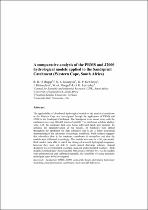 ResearchSpace
ResearchSpace
Comparative analysis of the PRMS and J2000 hydrological models applied to the Sandspruit Catchment, Western Cape, South Africa
JavaScript is disabled for your browser. Some features of this site may not work without it.
- ResearchSpace
- →
- Research Publications/Outputs
- →
- Conference Publications
- →
- View Item
| dc.contributor.author |
Bugan, Richard DH

|
|
| dc.contributor.author |
Jovanovic, Nebojsa

|
|
| dc.contributor.author |
De Clercq, WP

|
|
| dc.contributor.author |
Helmschrot, J

|
|
| dc.contributor.author |
Fluegel, WA

|
|
| dc.contributor.author |
Leavesley, GH

|
|
| dc.date.accessioned | 2010-08-15T13:02:24Z | |
| dc.date.available | 2010-08-15T13:02:24Z | |
| dc.date.issued | 2009-12 | |
| dc.identifier.citation | Bugan, R.D.H., Jovanovic, N., De Clercq, W.P. et al. 2009. Comparative analysis of the PRMS and J2000 hydrological models applied to the Sandspruit Catchment, Western Cape, South Africa. Management of Natural Resources, Sustainable Development and Ecological Hazards, II, pp 391-402 | en |
| dc.identifier.uri | http://hdl.handle.net/10204/4148 | |
| dc.description | Management of Natural Resources, Sustainable Development and Ecological Hazards, II | en |
| dc.description.abstract | The applicability of distributed hydrological models to the semi-arid conditions in the Western Cape was investigated through the application of PRMS and J2000 in the Sandspruit Catchment. The Sandspruit is an annual river, with the catchment receiving 300-400 mm/a of rainfall. The catchment exhibits shallow soils, with the dominant land uses being cultivated lands and pastures. To optimise the parameterisation of the models, 21 boreholes were drilled throughout the catchment for data collection and to get a better conceptual understanding of the catchment’s hydrologic conditions. Field evidence suggests that subsurface flow is the dominant contributor of stream flow and thus the models were calibrated accordingly. The models were run for a 20 year period. Both models were able to match the timing of seasonal hydrograph responses; however they were not able to match annual discharge volumes. Annual discharge was overestimated in certain cases and underestimated in others. Both models exhibited daily Nash-Sutcliffe Efficiencies of below 0.4. As the models were parameterised and calibrated manually, the feasibility of using automatic techniques needs to be investigated | en |
| dc.language.iso | en | en |
| dc.subject | Sandspruit catchment | en |
| dc.subject | Hydrologic modelling | en |
| dc.subject | J2000 hydrological model | en |
| dc.subject | Semi arid climate | en |
| dc.subject | Western Cape | en |
| dc.subject | Ecological hazards | en |
| dc.subject | Natural resources | en |
| dc.subject | River catchments | en |
| dc.title | Comparative analysis of the PRMS and J2000 hydrological models applied to the Sandspruit Catchment, Western Cape, South Africa | en |
| dc.type | Conference Presentation | en |
| dc.identifier.apacitation | Bugan, R. D., Jovanovic, N., De Clercq, W., Helmschrot, J., Fluegel, W., & Leavesley, G. (2009). Comparative analysis of the PRMS and J2000 hydrological models applied to the Sandspruit Catchment, Western Cape, South Africa. http://hdl.handle.net/10204/4148 | en_ZA |
| dc.identifier.chicagocitation | Bugan, Richard DH, Nebojsa Jovanovic, WP De Clercq, J Helmschrot, WA Fluegel, and GH Leavesley. "Comparative analysis of the PRMS and J2000 hydrological models applied to the Sandspruit Catchment, Western Cape, South Africa." (2009): http://hdl.handle.net/10204/4148 | en_ZA |
| dc.identifier.vancouvercitation | Bugan RD, Jovanovic N, De Clercq W, Helmschrot J, Fluegel W, Leavesley G, Comparative analysis of the PRMS and J2000 hydrological models applied to the Sandspruit Catchment, Western Cape, South Africa; 2009. http://hdl.handle.net/10204/4148 . | en_ZA |
| dc.identifier.ris | TY - Conference Presentation AU - Bugan, Richard DH AU - Jovanovic, Nebojsa AU - De Clercq, WP AU - Helmschrot, J AU - Fluegel, WA AU - Leavesley, GH AB - The applicability of distributed hydrological models to the semi-arid conditions in the Western Cape was investigated through the application of PRMS and J2000 in the Sandspruit Catchment. The Sandspruit is an annual river, with the catchment receiving 300-400 mm/a of rainfall. The catchment exhibits shallow soils, with the dominant land uses being cultivated lands and pastures. To optimise the parameterisation of the models, 21 boreholes were drilled throughout the catchment for data collection and to get a better conceptual understanding of the catchment’s hydrologic conditions. Field evidence suggests that subsurface flow is the dominant contributor of stream flow and thus the models were calibrated accordingly. The models were run for a 20 year period. Both models were able to match the timing of seasonal hydrograph responses; however they were not able to match annual discharge volumes. Annual discharge was overestimated in certain cases and underestimated in others. Both models exhibited daily Nash-Sutcliffe Efficiencies of below 0.4. As the models were parameterised and calibrated manually, the feasibility of using automatic techniques needs to be investigated DA - 2009-12 DB - ResearchSpace DP - CSIR KW - Sandspruit catchment KW - Hydrologic modelling KW - J2000 hydrological model KW - Semi arid climate KW - Western Cape KW - Ecological hazards KW - Natural resources KW - River catchments LK - https://researchspace.csir.co.za PY - 2009 T1 - Comparative analysis of the PRMS and J2000 hydrological models applied to the Sandspruit Catchment, Western Cape, South Africa TI - Comparative analysis of the PRMS and J2000 hydrological models applied to the Sandspruit Catchment, Western Cape, South Africa UR - http://hdl.handle.net/10204/4148 ER - | en_ZA |





